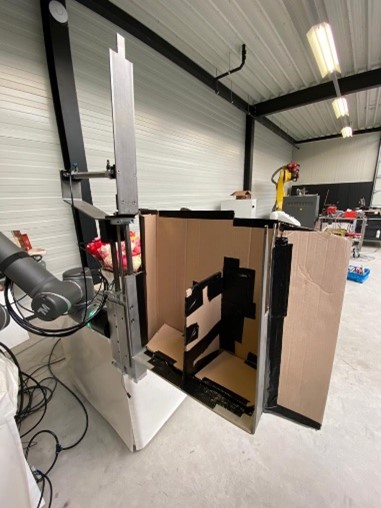Groepsleden:
Linkedin Dave Ravensbergen
Linkedin Mark de Roos
Linkedin Martijn Venselaar
Linkedin Guus Zwart
Original Situation
DERO is a company that designs, produces and installs automated processes. They got contacted if they could design a robotic arm to put tulips into rectangular casks. This means that a robotic arm can first collect 25 bouquets, containing ten tulips each, and second put these in a rectangular casks. These casks can then be transported to the storage or directly to a truck heading towards the auction. This job is now done by a conveyer belt worker who does the same job every day.

Assignment
We as a group got the assignment to work on a solution for the automation to collect the 25 bouquets and placing them in the cask. This means we had to design and build a setup which is capable of these actions and does this by itself. The setup does not have to be ready for production purposes, it is meant as a proof of concept to test if its viable as a solution and a replacement of the conveyer belt worker. This project uses plastic flowers for easy use and not destroying the tulips by using them over and over. This project has a timespan of 7 weeks.

Solution
The flowers are brought in by conveyer belt to simulate the machine before it which puts the wrapping around the bouquets. Under the conveyer belt is the end of arm tool and the support beam. The end of arm tool is a catching device in the shape of the cask but a bit smaller. The tool has two pistons connected to it. The first is to close and open a bar for enclosing the flowers. The second is to raise or lower the bar. This is used to compress the flowers so they fit in the cask. The support beam is used to support the stems so they don’t fall. This end of arm tool is attached to a Techman tm12 robotic arm. This moves the tool and the flowers above and in the cask. Here the bar opens and the tool moves away. Now only the filled cask remains.

Major decisions
During the time spent on this project many major decisions were made and changed. First was the use of the robotic arm. Before we started, we were told we can use a FANUC M-710 arm to attach the end of arm tool to. This is a more industrial robotic arm with a higher maximum payload. While we started with this robot, we got the news that the company needed the robot for another project. In this we had to quickly switch to another robotic arm. This became the Techman 12. A problem with this robot is the payload. This was a challenge to fit the tool on it with flowers and not go past the maximum payload.
The end of arm tool was also a major decision. This tool changed a lot during the weeks. After we made the base, which is the metal u-shaped tool we had to figure out what the best shape of the box behind it was. Here we tried a lot of shapes till we eventually found the right one. There is also a middle panel to divide the two sides. This is to make sure that the flowers don’t slide all over and that the bottom flowers don’t go to crooked. This will make sure that the next layers are more evenly dispensed. The connection to the robotic arm also changed because we switched from the FANUC to the Techman.
The final decision was the movement for catching the flowers. We had to make sure that the flowers are nice and evenly spread and as straight as possible. This made sure we had to try a lot of different techniques. We found that holding the tool under an angle was pretty effective. This made sure that the outside ones always go towards the end. The middle ones rolled often between the outside ones. This was only as much a bad thing as a good thing. It was nice that they rolled in between, but this meant that more often than not they rolled in every angle but not in a straight line. This way the flower blocked a spot and it wasn’t evenly placed. This was solved with the middle panel. This made sure there were only sides.

Conclusion and recommendations
We can conclude that it is possible to automate the placing of 25 bouquets into the rectangular casks. The setup right now doesn’t have the speed of the conveyer belt and the worker due to the available equipment not being able to match the speed. We would recommend to use a stronger robotic arm like the FANUC and then test this concept with real tulips.
We would like to thank the people at DERO for offering this exciting assignment and providing the place and equipment needed for testing.